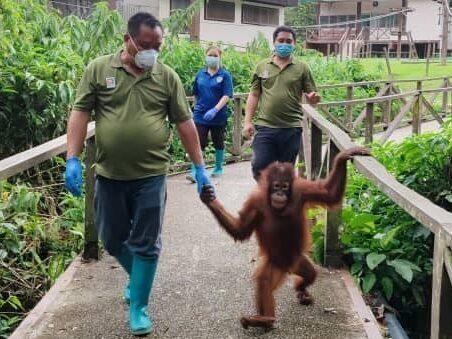News
Releasing King Ghaz
Original footage from the world's first helicopter translocation of an orangutan in 2001.
26/12/2020
A world first
The Rehabilitation Centre was buzzing with excitement the day we arrived in Sabah, for it meant King Ghaz, a male orangutan in his prime, would at last be returned to the wild.
For a number of months, King had been confined to a holding cage after he began to display territorial aggression in the area of the reserve surrounding the centre.
It must be stressed however that this was an isolated case. Orangutans are strong but also gentle creatures, and it is almost unheard of for them to attack humans or other animals, and even then only in self-defence.
Concern for King’s health was growing among the group as everyday he spent in captivity heightened the risk of permanent psychological damage.
But our arrival meant the start of an unprecedented operation - King was to be flown by helicopter from Sepilok to a remote part of the Tabin Reserve on the other side of Borneo and returned to the wild.
The project required two teams - relocation and reconnaissance. The relocation team, led by Dr Sen Nathan, Sabah’s chief wildlife vet, was responsible for sedating and transporting King safely. The team included most of Sepilok’s rangers, and appeal members Sue Sheward and Claire Shellim.
The reconnaissance team, headed by Melvin, the senior ranger, included our other appeal members Jane Mullins, Chris Yarwood and two of the centre’s most experienced trackers. The team was responsible for trekking through the remote jungle to find and mark a suitable landing site for the helicopter.
After 4 days in the jungle the recce team located the chosen landing spot, a mud volcano. Flare guns at the ready, and co-ordinates confirmed, they waited for the sound of the chopper blades. On the big day, everyone gathered to watch King’s sedation.The compartment was heavy and took 4 men to lift without King inside. It took 10 men to load him onto the pick-up truck and helicopter.
Time was short as the sedative was only guaranteed to keep King asleep for an hour, so time was of the essence, but disaster was also close at hand – the box was 3” too tall for the helicopter doorway. Sue and Claire were terrified King would not be set free.
But Dr Sen and his rangers quickly found that by laying the compartment on its side it fitted. We were all relieved but time was ticking on and we had a 40 min flight ahead, and King would soon be awake.
King releasedBut in no time at all we were there and King was lifted to the edge of the jungle, so he could slowly recover in the shade. The most emotional moment for everyone was when King slowly opened his eyes and gazed in disbelief at the canopy above him. He plucked a leaf, and brought it to his nose just to make sure it was real.
We stayed with King for several hours while he recovered from his sedation, giving him water to drink and shading him with palm branches from the glaring midday sun.
Throughout this period King showed no signs of aggression. Soon he wandered off into the jungle, pausing briefly to glance over his shoulder at us – as if to say thank you.
We're are pleased to share with you this very special original footage from the world's first inside helicopter translocation of an orangutan in 2001.
This was one of the first projects funded by Orangutan Appeal UK. The film tells King Ghaz's story from an orphaned orangutan to his translocation to the Tabin reserve in Borneo.
The translocation was funded by Orangutan Appeal UK but was only possible because of the hard work and dedication of the team at Sepilok Orangutan Rehabilitation Centre and the Sabah Wildlife Department.
Explore more articles
![Planet vs Plastic]()
News
Earth Day, 22 April 2024
This years theme, "Planet vs. Plastics", prompts reflection on the devastating impact of plastic waste.
![Oyo]()
News
Celebrate Easter with our fun activity ideas
We're putting an orangutan-themed spin on some Easter activities for the whole family.
![Luffy goes to next stage of rehabilitation]()
News
Luffy in final stage of his rehabilitation
After 5 years at Sepilok, Luffy is ready for the next challenge.


